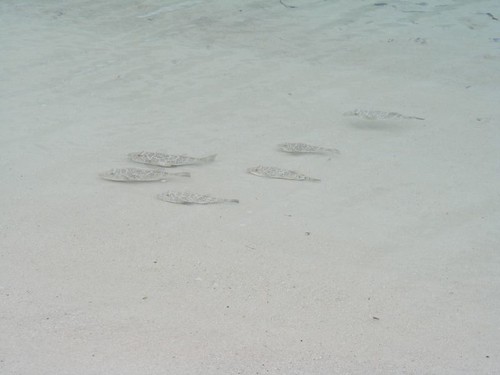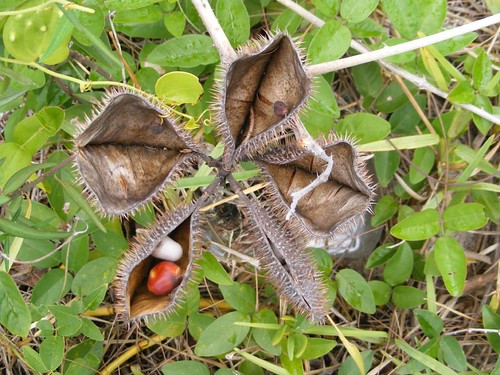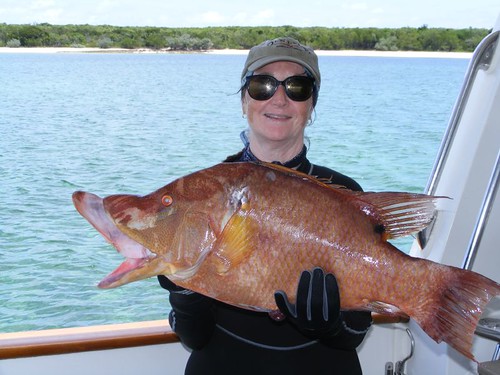Allans-Pensacola Cay
July 4 – 9, 2010
After we pulled up the anchor from our Green Turtle Cay anchorage, we moved northwest to one of our favorite spots, Allans-Pensacola Cay. APC is really another world compared to parts south, and it is the real reason we come to the Bahamas. We would have been here sooner if we hadn't had the problems with the refrigerator. While we always see other boats here, most cruisers only stay a couple of nights and then move on to populated areas. There are no goods or services available close by, so you have to come here prepared to be on your own for the most part. Here, we can jump off the boat and not have to worry about getting run over by a day boater rushing to the next bar or party site.
We did have some “activity” in the anchorage for the 4th of July celebration. A boat with 7 people in their 20s dropped anchor. At night they went to the beach and shot off colorful fireworks that were really nice to watch in the pitch black night with the beach, island trees, and water silhouetted in the glowing sparkles. Unfortunately, they left behind all the fireworks garbage right on the beach, to be washed into the sea with the high tide, so I made an early run to the beach and picked everything up. I think if I ever have a break down and go crazy on the high seas I will shoot people who leave garbage behind with my spear!
The water off the sandy beaches in this area is so clear, as you can see in the opening photo of the school of puffer fish I saw on one of my beach walks. As much as I enjoy snorkeling the exciting offshore reefs, I still delight in walking through the calm shallows and hunting for other marine life. There is always something to see in the water, washed up on the beach, or in the underbrush.
I thought it would be interesting to show what the Nicker Bean pods look like since a lot of people find the pretty oval, smooth, blue-gray seeds (they go in that class called sea beans) on tropical shores worldwide and never see the plant they come from. As smooth and benign as are the beans, everything about the plant is just the opposite. Not only are the pods full of prickly spines, but so are the stems. You can't even think about walking through a nicker bean bush, so it has been used as a barrier for people and livestock. I have been scratched and had my clothes torn many times.
Our favorite reason for stopping here is to be able to more easily access the offshore reefs when the weather is calm enough for us to take the dinghy a couple of miles out. Since this area is remote, with no real settlements like those to the south that harbor permanent residents and large numbers of tourists, there is still a lot of marine life and edible fish to be found. We were finally able to find vibrant coral heads with lots of “game” fish and other abundant species of fish. Even if we aren't able to catch anything, it is fun searching and watching all the underwater activity. On days we get skunked and come back empty-handed, we placate ourselves with comfort food like Klondike bars!
Eddie and I are very competitive when it comes to spearfishing, but we are always cheering each other on when going after a good fish. I still can't believe I was lucky enough to find this 12.5 lb. prized hogfish, spear it, and be able to get it to the surface for Wayne to pick up. It is by far the biggest fish we have speared and a real dream come true, no matter who caught it. To give you some perspective, we are usually happy to be able to get them in the 3 lb. range, and if we get a 5 lb. one, we are elated.
Eddie says I should explain why we spear hogfish. First, we like to be able to get them because they are delicious to eat, and we are hoping that eating more fish will make us smarter. Their meat is so white and firm, freezes well and can be cooked a number of ways. That makes it worthwhile to spend the time to try to hunt them. Secondly, if found, they are easier to spear than other fish. Their broad bodies make a better target. However, hogfish rely on the art of camouflage to get away from their natural predators. They can change colors right before your eyes to blend in with their background, instead of going into a hole or under a ledge like other fish, and then they think they are safe. So, they remain very still thinking the predator won't notice them. Well, humans aren't their natural predator, so that “trick” doesn't work as well on us. If we can sneak up close enough to them without startling them, we can get a shot off. It isn't really as easy as it sounds because we are trying to do this all on one breath, knowing that we have to have enough air left to get back up to the surface with a heavy fish on the end of the spear. Plus, we are using pole spears which rely on being propelled by a big rubber loop, which is very difficult for me to stretch to the limit to get enough force to get the spear points through a fish using only one arm. The tighter you can stretch the rubber, the more power you will have in the spear. Some mornings my knuckles are sore from having gripped my spear so tightly. Plus, I think we are both developing a case of spear elbow, a distant relative of tennis elbow!
Now don't think we just lay idle in between our fishing forays swatting horseflies (there are many in this place and their bite is painful!). The W & E Marine Rescue Team saved a sailboat from a potentially unpleasant grounding. A sailboat that we had seen several times down “south” was also in our anchorage and left one morning. We noticed that it had gone a ways and then stopped. Before long, the captain had a halyard line strung from his mast and was trying to heel the boat over with his little dinghy. We knew he was aground, and it was only an hour past high tide, which meant he wouldn't have enough water to refloat his boat for 11 hours if he didn't get it off ASAP. I called the boat on the VHF and asked if they needed our help since we had a bigger, more powerful dinghy. W & E went to the scene and were able to work from the water while the captain used his engine to get the sailboat off the hump he had run up on.
We couldn't really blame the captain for ineptitude because he gave us the lat/long of the spot where he went aground, and it was right on the course line on our chart; it could have just as well happened to us. However, the area is charted as having shifting sand bores. Those are bar areas associated with cuts between islands where the water rushes through, depositing sand and creating humps. The charted courses try to give enough leeway to avoid the bars, but they can change with varying weather conditions and tides, such that all captains should take careful notice to give them adequate clearance. It was even a lesson learned for the FLUKE crew. When in doubt, transiting the questionable area on a rising tide is in order or you may suffer the potential consequences.
Friday, August 06, 2010
Subscribe to:
Post Comments (Atom)











0 comments:
Post a Comment